Shear Strength of Geopolymer Concrete Beams Using High Calcium Content Fly Ash in a Marine Environment
Abstract
1. Introduction
2. Research Method
2.1. Specimens Details
- Series I—beams cured at room temperature (B1, B2, and B3)
- Series II—beams cured in seawater at the splashing zone (B4, B5, and B6)
2.2. Materials
- The ultrasonic pulse velocity (UPV) test
- Resistivity test
- Porosity test
2.3. Mixing and Curing
2.4. Testing Procedure
3. Results and Discussion
3.1. Compressive and Splitting Tensile Strength of Concrete Cylinders
3.2. Ultrasonic Pulse Velocity (UPV) Test
3.3. Resistivity Test
3.4. Porosity Test
3.5. Crack Development and Mode of Failure
3.6. Load Deflection Characteristic
3.7. Cracking and Ultimate Load
- -
- Vc = concrete shear strength (N)
- -
- Vs = steel shear reinforcement shear strength (N)
- -
- f’c = concrete strength (MPa)
- -
- bw = width of beam (mm)
- -
- d = effective depth of beam (mm)
- -
- Av = area of shear reinforcement (mm2)
- -
- fy = yield strength of steel reinforcement (MPa)
- -
- s = spacing of shear reinforcement (mm)
4. Conclusions and Future Work
Author Contributions
Funding
Acknowledgments
Conflicts of Interest
References
- Hardjito, D.; Rangan, B.V. Development and Properties of Low-Calcium Fly Ash-Based Geopolymer Concrete; Research and Report GC 1; Faculty of Engineering, Curtin University of Technology: Perth, Australia, 2005. [Google Scholar]
- Sofi, M.; van Deventer, J.; Mendis, P.; Lukey, G. Engineering properties of inorganic polymer concretes (IPCs). Cement Concrete Res. 2007, 37, 251–257. [Google Scholar] [CrossRef]
- Fernandez-Jimenez, A.M.; Palomo, A.; Lopez-Hombrados, C. Engineering properties of alkali-activated fly ash concrete. ACI Mater. J. 2006, 103, 106. [Google Scholar]
- Sofi, M.; van Deventer, J.; Mendis, P.; Lukey, G. Bond performance of reinforcing bars in inorganic polymer concrete (IPC). J. Mater. Sci. 2007, 42, 3107–3116. [Google Scholar] [CrossRef]
- Rangan, B. Engineering properties of geopolymer concrete. In Geopolymers: Structure, Processing, Properties and Applications; Provis, J.L., van Deventer, J.S.J., Eds.; Woodhead Publishing Ltd.: Sawston, UK, 2009. [Google Scholar]
- Wongpa, J.; Kiattikomol, K.; Jaturapitakkul, C.; Chindaprasirt, P. Compressive strength, modulus of elasticity, and water permeability of inorganic polymer concrete. Mater. Des. 2010, 31, 4748–4754. [Google Scholar] [CrossRef]
- Wallah, S.; Rangan, B.V. Low-Calcium Fly Ash-Based Geopolymer Concrete: Long-Term Properties; Research Report GC 2; Faculty of Engineering, Curtin University of Technology: Perth, Australia, 2006. [Google Scholar]
- Chindaprasirt, P.; Chalee, W. Effect of sodium hydroxide concentration on chloride penetration and steel corrosion of fly ash-based geopolymer concrete under marine site. Construct. Build. Mater. 2014, 63, 303–310. [Google Scholar] [CrossRef]
- Reddy, D.V.; Edouard, J.-B.; Sobhan, K. Durability of fly ash–based geopolymer structural concrete in the marine environment. J. Mater. Civ. Eng. 2012, 25, 781–787. [Google Scholar] [CrossRef]
- Badar, M.S.; Kupwade-Patil, K.; Bernal, S.A.; Provis, J.L.; Allouche, E.N. Corrosion of steel bars induced by accelerated carbonation in low and high calcium fly ash geopolymer concretes. Construct. Build. Mater. 2014, 61, 79–89. [Google Scholar] [CrossRef]
- Gunasekara, C.; Law, D.W.; Setunge, S. Long term permeation properties of different fly ash geopolymer concretes. Construct. Build. Mater. 2016, 124, 352–362. [Google Scholar] [CrossRef]
- Chindaprasirt, P.; Chareerat, T.; Hatanaka, S.; Cao, T. High-strength geopolymer using fine high-calcium fly ash. J. Mater. Civ. Eng. 2010, 23, 264–270. [Google Scholar] [CrossRef]
- Zeng, S.; Wang, J. Characterization of mechanical and electric properties of geopolymers synthesized using four locally available fly ashes. Construct. Build. Mater. 2016, 121, 386–399. [Google Scholar] [CrossRef]
- Bayuaji, R.; Darmawan, M.S.; Wibowo, B.; Husin, N.; Subekti, S. Utilization of High Calcium Content Fly Ash: Flexural Strength of Geopolymer Concrete Beams in Sea Water Environment. Open Civ. Eng. J. 2016, 10, 782–793. [Google Scholar] [CrossRef]
- Sumajouw, D.M.J.; Hardjito, D.; Wallah, S.E.; Rangan, B.V. Behavior and strength of reinforced fly ash-based geopolymer concrete beams. Presented at the Australian Structural Engineering Conference Australia, Newcastle, Australia, 11–14 September 2005. [Google Scholar]
- Sumajouw, M.; Rangan, B.V. Low-Calcium Fly Ash-Based Geopolymer Concrete: Reinforced Beams and Columns; Curtin University of Technology: Perth, Australia, 2006. [Google Scholar]
- Dattatreya, J.K.; Rajamane, N.P.; Sabitha, D.; Ambily, P.S.; Nataraja, M.C. Flexural behavior of reinforced geopolymer concrete beams. Int. J. Civ. Struct. Eng. 2011, 2, 138–159. [Google Scholar]
- Yost, J.R.; Radlińska, A.; Ernst, S.; Salera, M.; Martignetti, N.J. Structural behavior of alkali activated fly ash concrete. Part 2: Structural testing and experimental findings. Mater. Struct. 2013, 46, 449–462. [Google Scholar] [CrossRef]
- Prachasaree, W.; Limkatanyu, S.; Hawa, A.; Samakrattakit, A. Development of equivalent stress block parameters for fly-ash-based geopolymer concrete. Arab. J. Sci. Eng. 2014, 39, 8549–8558. [Google Scholar] [CrossRef]
- Ren, J.R.; Chen, H.G.; Sun, T.; Song, H.; Wang, M.S. Flexural behavior of combined FA/GGBFS geopolymer concrete beams after exposure to elevated temperatures. Adv. Mater. Sci. Eng. 2017, 2017, 6854043. [Google Scholar] [CrossRef]
- Mourougane, R.; Puttappa, C.G.; Sashidhar, C.; Muthu, K.U. Shear behavior of high strength GPC/TVC beams. Proc. Int. Conf. Adv. Arch. Civ. Eng. 2012, 21, 142. [Google Scholar]
- Topark-Ngarm, P.; Chindaprasirt, P.; Sata, V. Setting time, strength, and bond of high-calcium fly ash geopolymer concrete. J. Mater. Civ. Eng. 2014, 27, 04014198. [Google Scholar] [CrossRef]
- Standard Specification for Coal Fly Ash and Raw or Calcined Natural Pozzolan for Use in Concrete; ASTM International: West Conshohocken, PA, USA, 2019.
- Bayuaji, R.; Darmawan, M.S.; Husin, N.A.; Anugraha, R.B.; Budipriyanto, A.; Stewart, M.G. Corrosion damage assessment of a reinforced concrete canal structure of power plant after 20 years of exposure in a marine environment: A case study. Eng. Fail. Anal. 2018, 84, 287–299. [Google Scholar] [CrossRef]
- ASTM-C597-16, Standard Test Method for Pulse Velocity through Concrete (Annual Book of ASTM Standards, Vol. 04.02); ASTM International: West Conshohocken, PA, USA, 2016.
- BS-1881. Recommendations for Measurement of Velocity of Ultrasonic Pulses in Concrete; British Standards Institution (BSI): London, UK, 1986.
- Hornbostel, K.; Larsen, C.K.; Geiker, M.R. Relationship between concrete resistivity and corrosion rate—A literature review. Cement Concrete Compos. 2013, 39, 60–72. [Google Scholar] [CrossRef]
- Recommendations, R. Absorption of water by immersion under vacuum. Mater. Struct. 1984, 17, 391–394. [Google Scholar]
- Chen, X.; Wu, S.; Zhou, J. Influence of porosity on compressive and tensile strength of cement mortar. Construct. Build. Mater. 2013, 40, 869–874. [Google Scholar] [CrossRef]
- Kim, Y.Y.; Lee, K.M.; Bang, J.W.; Kwon, S.J. Effect of W/C ratio on durability and porosity in cement mortar with constant cement amount. Adv. Mater. Sci. Eng. 2014, 2014, 273460. [Google Scholar] [CrossRef]
- ACI Committee 318. Building Code Requirements for Structural Concrete (ACI 318-02); American Concrete Institute: Farmington Hills, MI, USA, 2002.
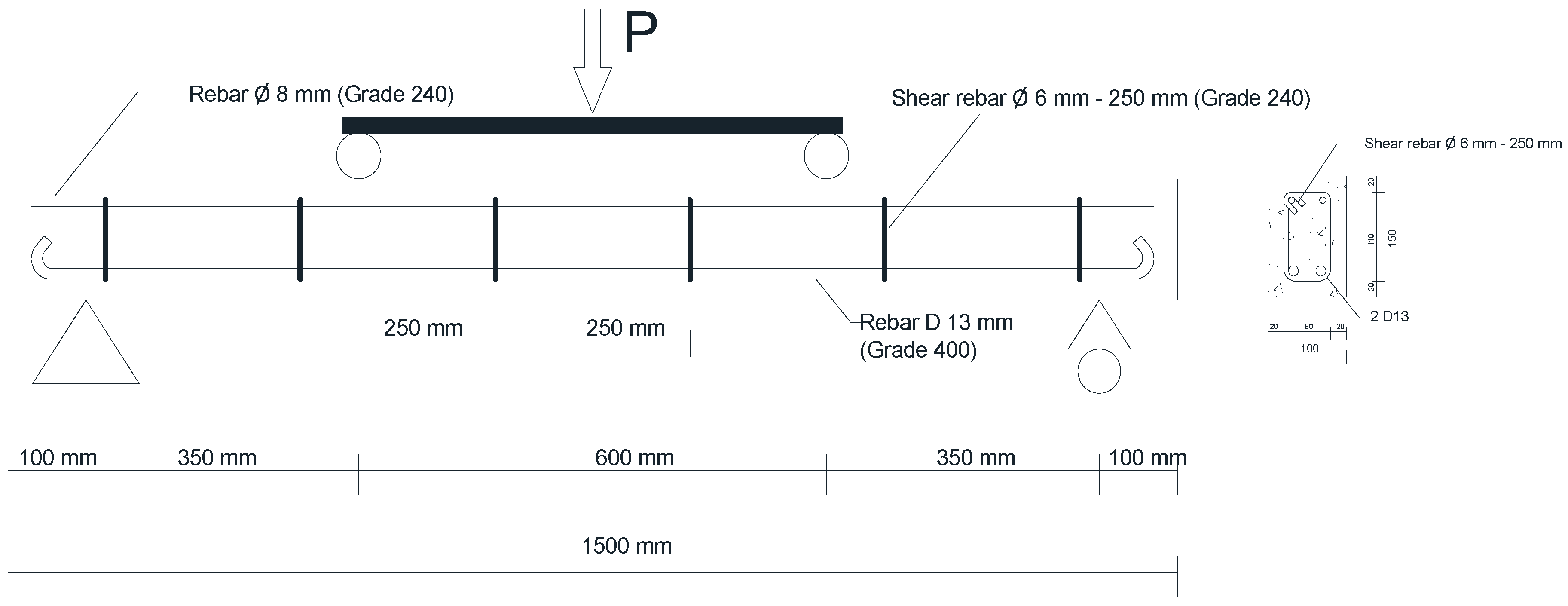
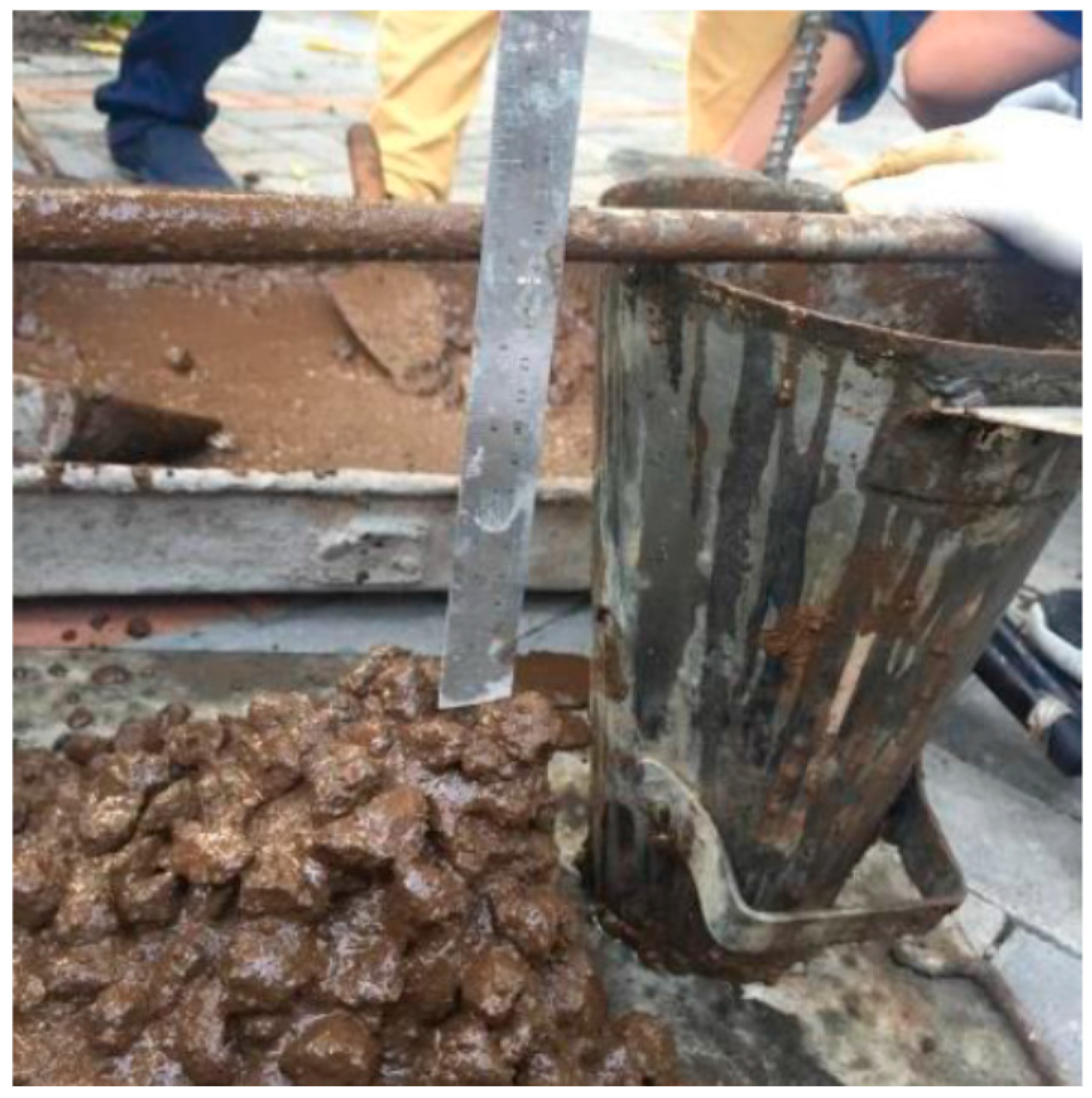
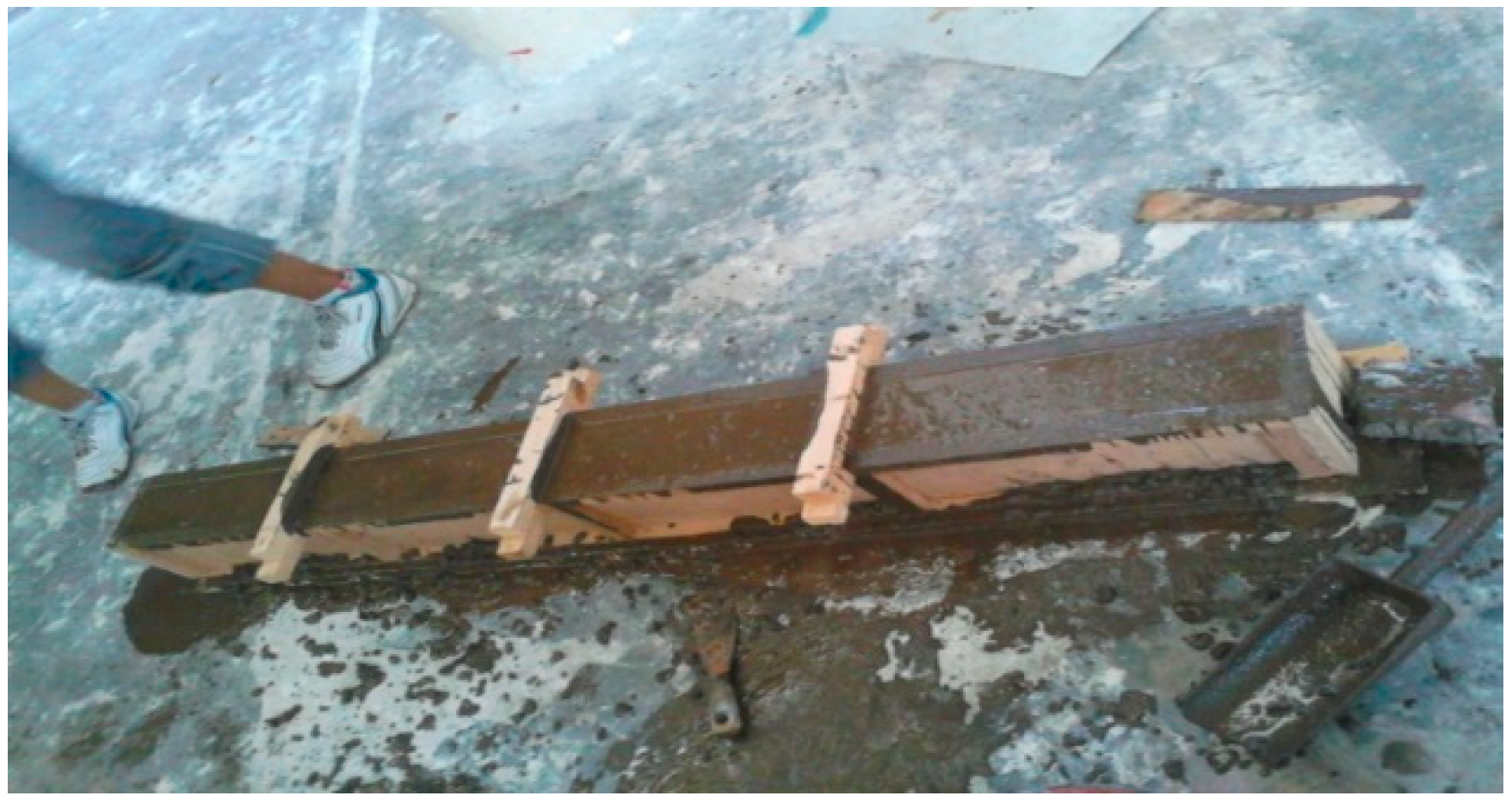
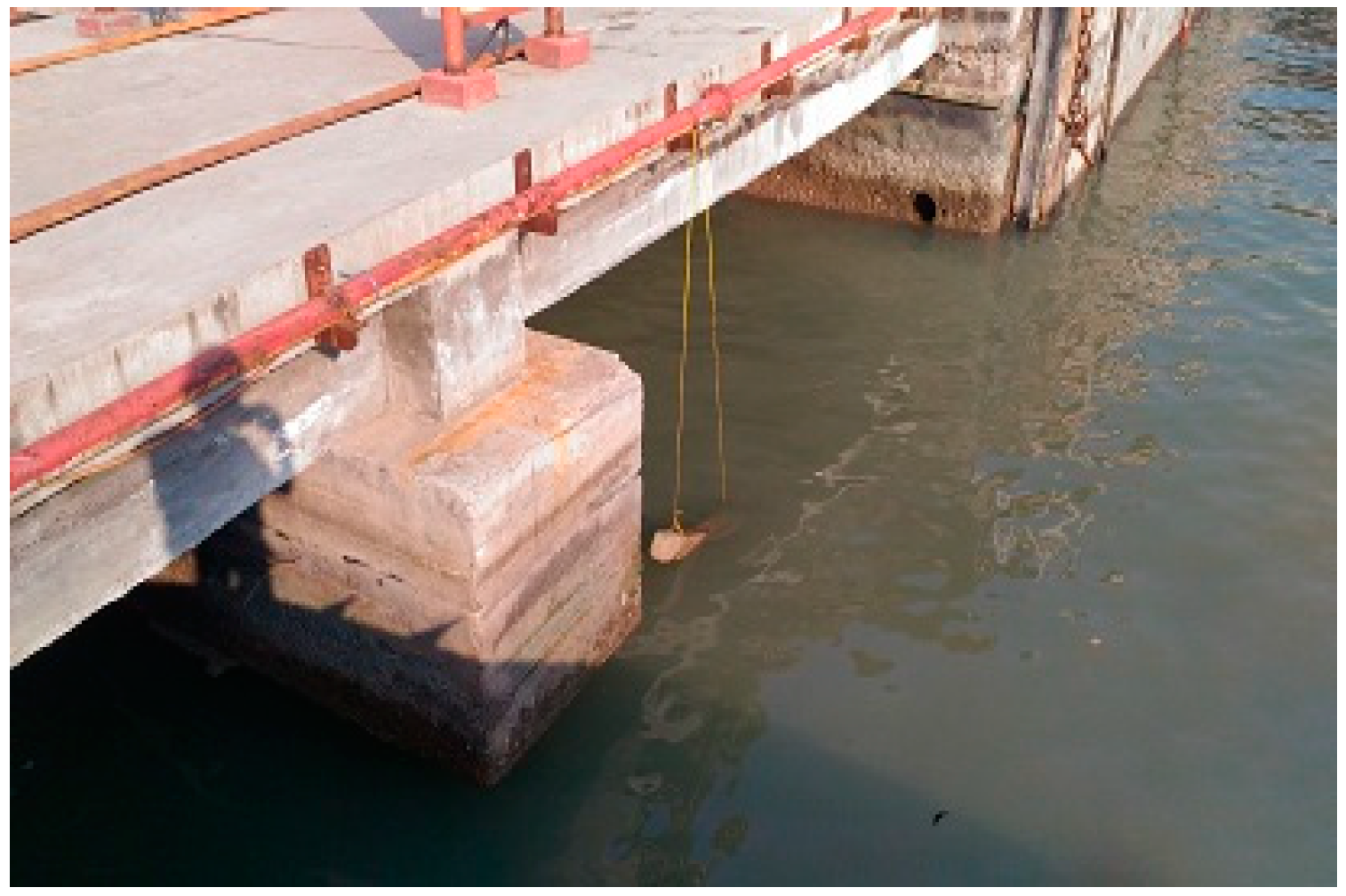
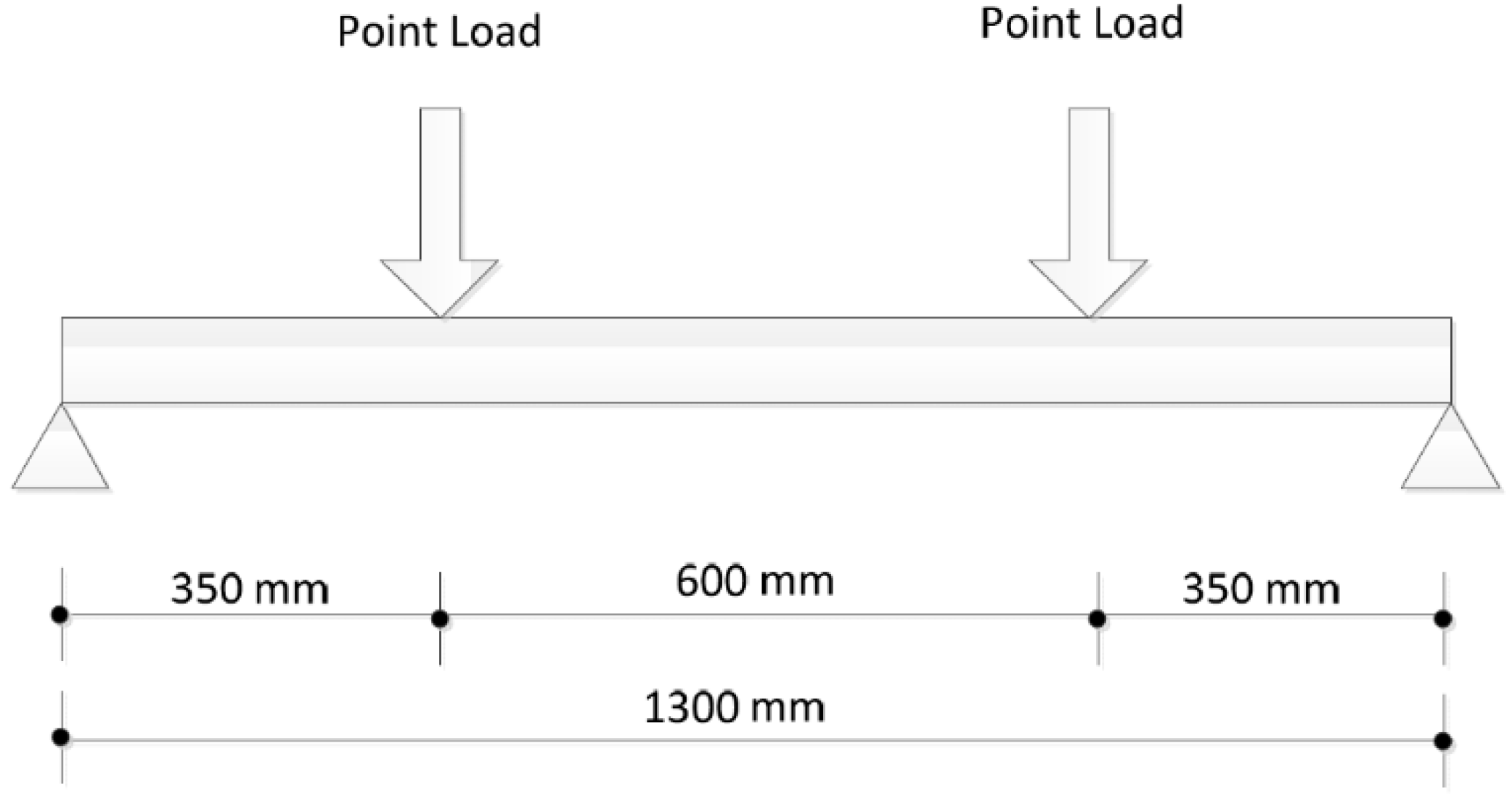
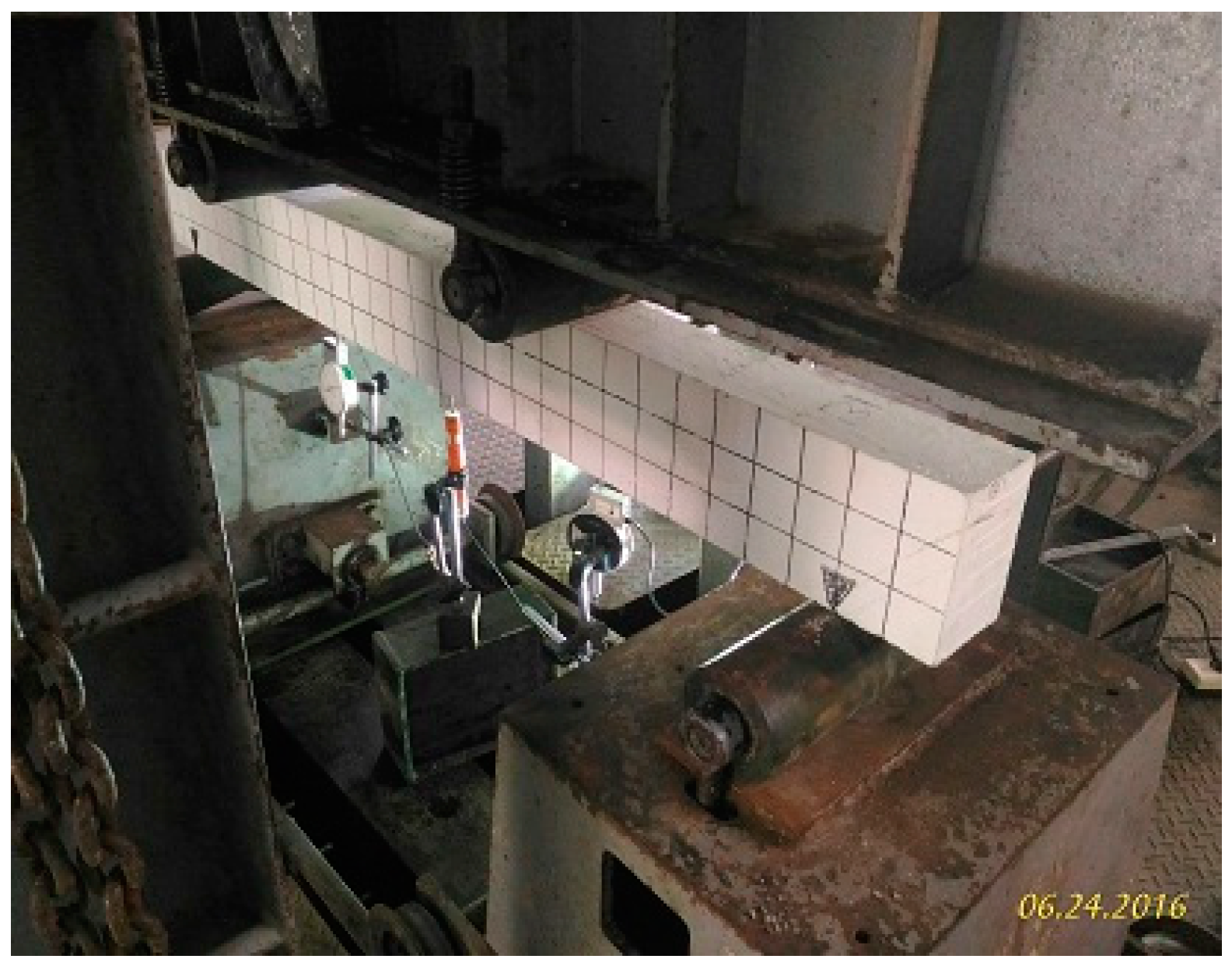
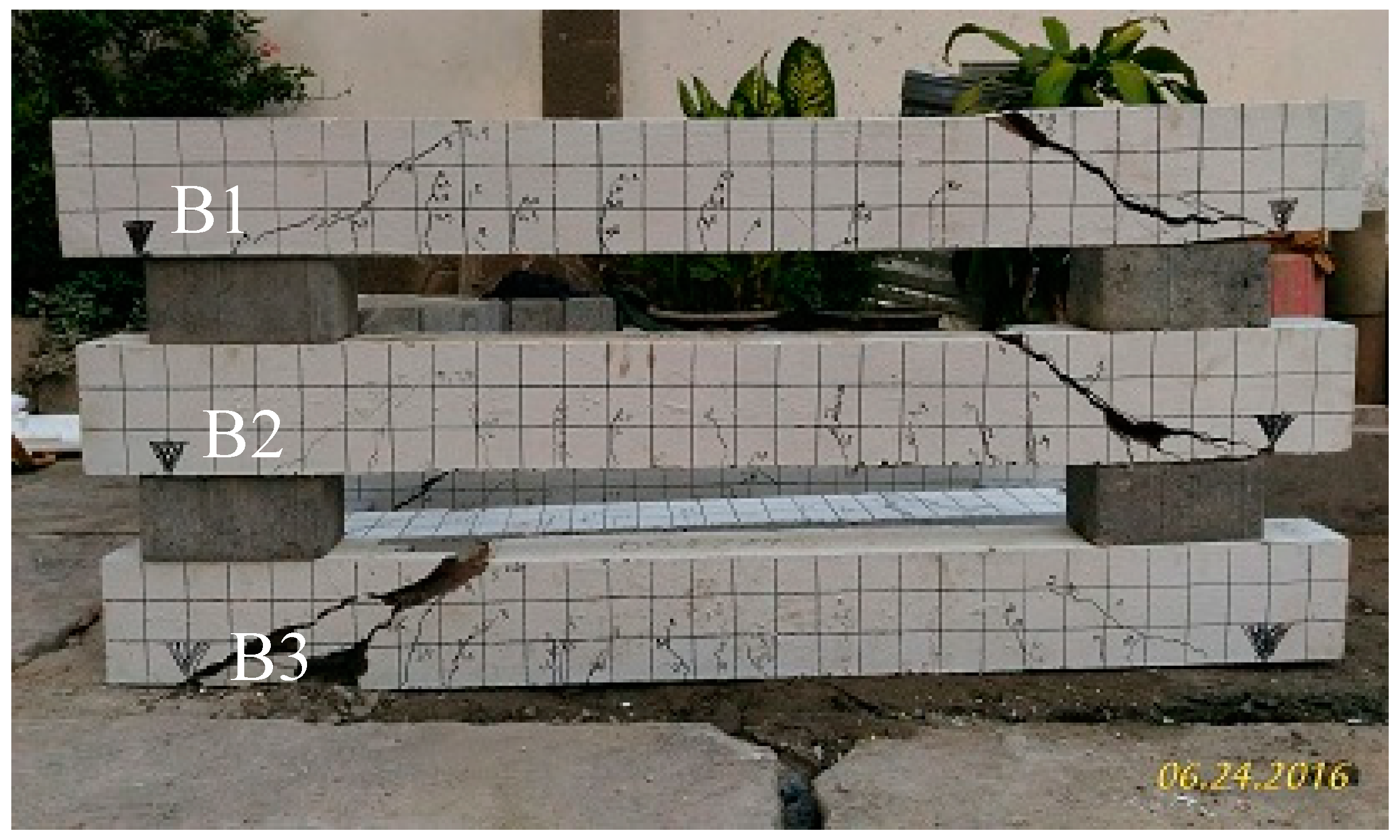
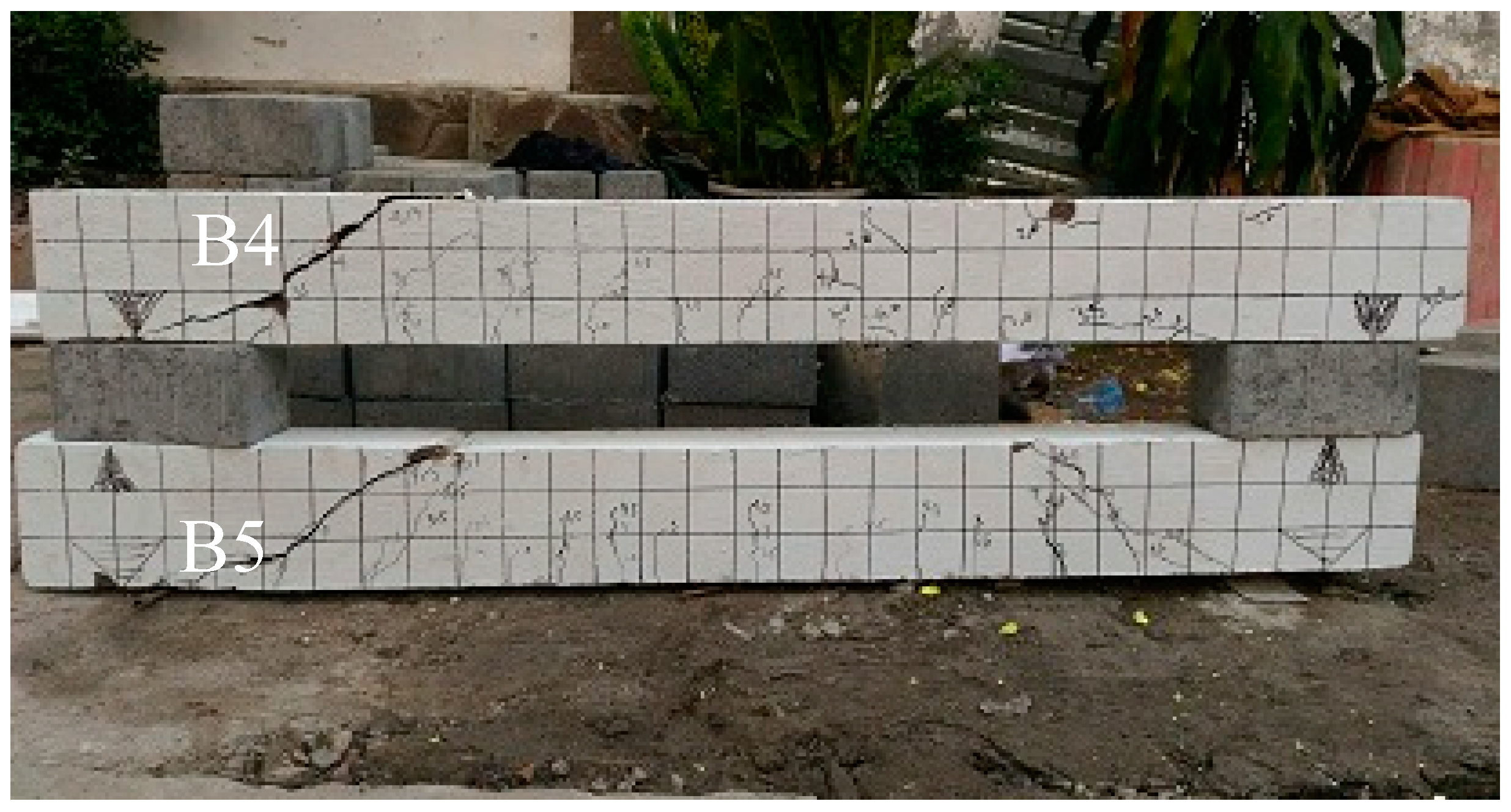
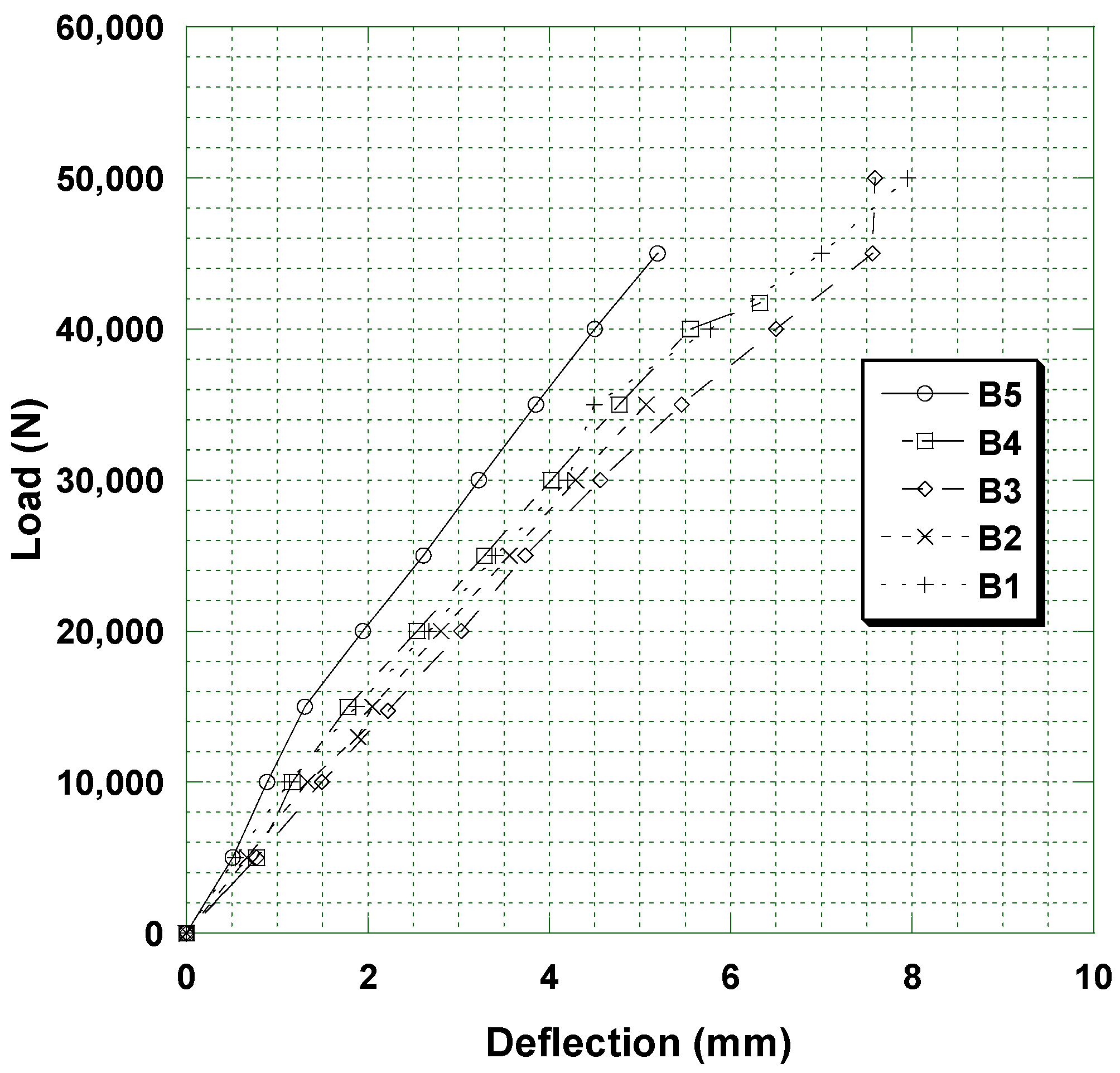
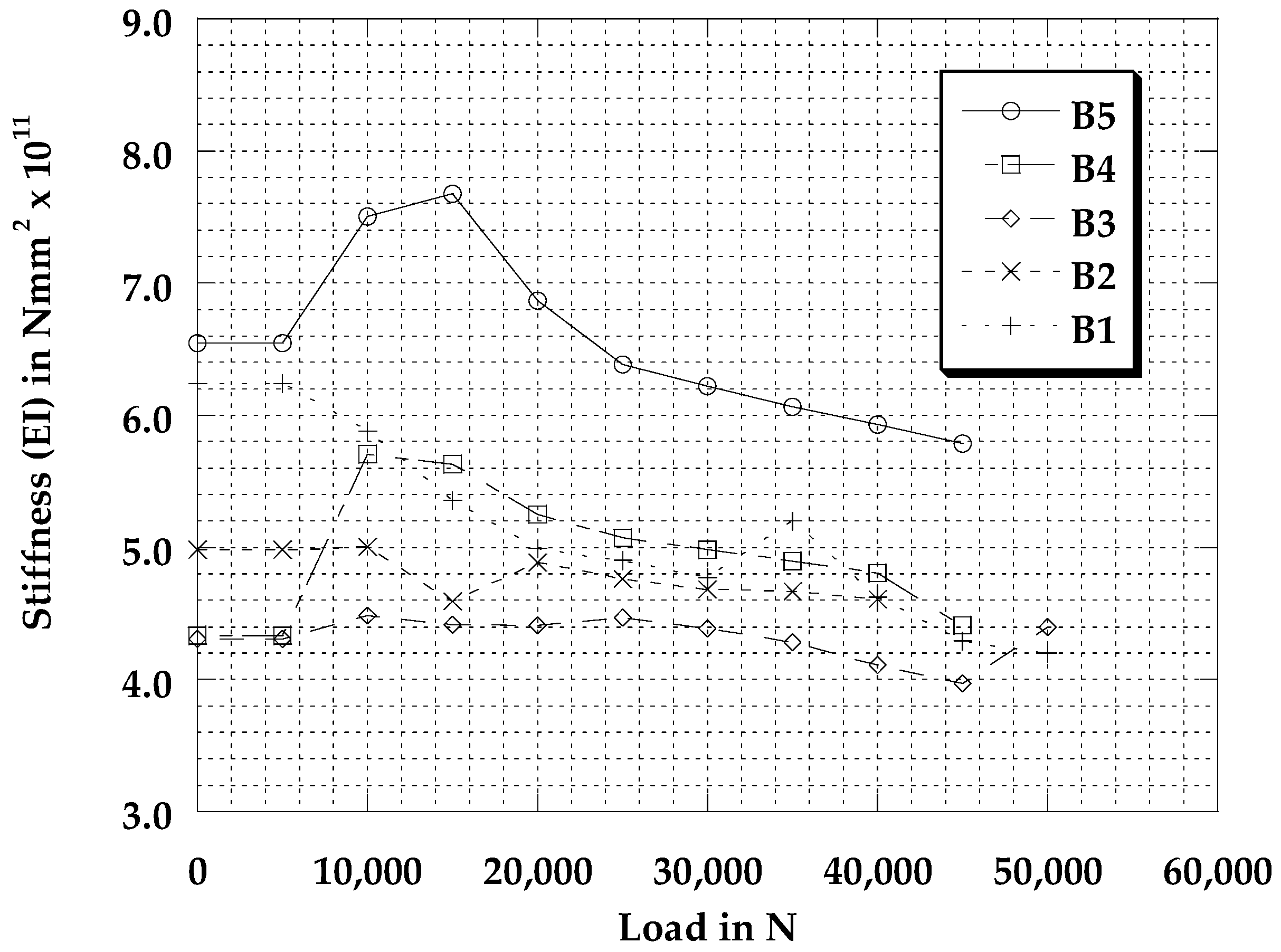
| Oxides | Weight (%) | |
|---|---|---|
| This Study | Previous Study [14] | |
| SiO2 | 40.60 | 41.97 |
| Al2O3 | 10.19 | 15.55 |
| CaO | 17.98 | 14.15 |
| MgO | 4.21 | 6.19 |
| Na2O | 0.77 | 2.26 |
| K2O | 1.80 | 1.73 |
| TiO2 | 1.03 | 0.87 |
| Fe2O3 | 20.43 | 14.16 |
| SO3 | 2.06 | 2.12 |
| P2O5 | 0.23 | 0.22 |
| MnO | 0.16 | 0.12 |
| SrO | 0.54 | 0.65 |
| Total | 100.00 | 100.00 |
| Material | Quantity (kg) | |
|---|---|---|
| This Study | Previous Study [14] | |
| Fly ash | 468 | 504 |
| Coarse aggregate | 1008 | 1008 |
| Fine aggregate | 672 | 672 |
| NaOH | 84 (8M) | 86.4 (14M) |
| Na2SiO3 | 168 | 123.2 |
| Superplasticizer | 9.36 | 15.2 |
| Added water | 0 | 10.08 |
| Na2SiO3: NaOH | 2.0 | 1.43 |
| Parameter | Sample 1 | Sample 2 |
|---|---|---|
| pH | 7.70 | 7.25 |
| Chloride (mg/L) | 19,000 | 17,000 |
| Sulfate (mg/L) | 2471 | 2203 |
| Series | Sample | Compressive Strength (MPa) | Average | Splitting Tensile Strength (MPa) | Average | Ratio to Compressive Strength |
|---|---|---|---|---|---|---|
| I | B1 | 25.97 | 35.09 | 2.38 | 2.91 | 0.08 |
| B2 | 32.84 | 2.73 | ||||
| B3 | 46.47 | 3.63 | ||||
| II | B4 | 22.02 | 24.78 | 2.96 | 3.05 | 0.12 |
| B5 | 24.82 | 3.08 | ||||
| B6 | 27.50 | 3.12 |
| Series | V (m/s) | Average V (m/s) | Average Compressive Strength (MPa) | |
|---|---|---|---|---|
| I | 2580 | 2637 | 3087 | 35.09 |
| 2697 | 3845 | |||
| 3180 | 3580 | |||
| II | 2967 | 3430 | 3237 | 24.78 |
| 3087 | 3347 | |||
| 3387 | 3207 | |||
| Series | Resistivity (kΩcm) | Average Resistivity (kΩcm) | Average Compressive Strength (MPa) | |
|---|---|---|---|---|
| I | 3.90 | 4.93 | 3.99 | 35.09 |
| 3.33 | 5.10 | |||
| 3.03 | 3.67 | |||
| II | 2.23 | 2.30 | 2.25 | 24.78 |
| 2.07 | 2.23 | |||
| 2.23 | 2.43 | |||
| Code | Porosity (%) | Average Porosity (%) | Average Compressive Strength (MPa) |
|---|---|---|---|
| Series I | 10.33 | 10.94 | 35.09 |
| 11.07 | |||
| 11.43 | |||
| Series II | 10.83 | 11.37 | 24.78 |
| 11.11 | |||
| 12.11 |
| Specimen | Cracking Load Pcr (N) | Ultimate Load Pu (N) | Pcr/Pu | Pu/P design |
|---|---|---|---|---|
| B1 | 25,000 | 74,000 | 0.34 | 1.45 |
| B2 | 13,000 | 53,500 | 0.24 | 1.05 |
| B3 | 32,000 | 68,800 | 0.47 | 1.35 |
| B4 | 25,000 | 41,700 | 0.60 | 0.82 |
| B5 | 46,000 | 71,000 | 0.65 | 1.39 |
© 2019 by the authors. Licensee MDPI, Basel, Switzerland. This article is an open access article distributed under the terms and conditions of the Creative Commons Attribution (CC BY) license (http://creativecommons.org/licenses/by/4.0/).
Share and Cite
Darmawan, M.S.; Bayuaji, R.; Sugihardjo, H.; Husin, N.A.; Anugraha Affandhie, R.B. Shear Strength of Geopolymer Concrete Beams Using High Calcium Content Fly Ash in a Marine Environment. Buildings 2019, 9, 98. https://doi.org/10.3390/buildings9040098
Darmawan MS, Bayuaji R, Sugihardjo H, Husin NA, Anugraha Affandhie RB. Shear Strength of Geopolymer Concrete Beams Using High Calcium Content Fly Ash in a Marine Environment. Buildings. 2019; 9(4):98. https://doi.org/10.3390/buildings9040098
Chicago/Turabian StyleDarmawan, Muhammad Sigit, Ridho Bayuaji, Hidajat Sugihardjo, Nur Ahmad Husin, and Raden Buyung Anugraha Affandhie. 2019. "Shear Strength of Geopolymer Concrete Beams Using High Calcium Content Fly Ash in a Marine Environment" Buildings 9, no. 4: 98. https://doi.org/10.3390/buildings9040098
APA StyleDarmawan, M. S., Bayuaji, R., Sugihardjo, H., Husin, N. A., & Anugraha Affandhie, R. B. (2019). Shear Strength of Geopolymer Concrete Beams Using High Calcium Content Fly Ash in a Marine Environment. Buildings, 9(4), 98. https://doi.org/10.3390/buildings9040098





